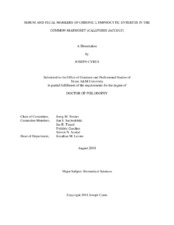| dc.description.abstract | Chronic lymphocytic enteritis (CLE) is a fatal condition in the common marmoset (C. jacchus) and is characterized by hypoalbuminemia. Fecal alpha1-proteinase inhibitor (α₁-PI) concentrations can be used to diagnose enteric protein loss in humans, dogs, and cats. Marmoset serum α₁-PI was purified using immunoaffinity and ceramic hydroxyapatite chromatography, and partial characterization was performed. A radioimmunoassay (RIA) and a sandwich enzyme-linked immunosorbent assay (ELISA) were developed and analytically validated for the measurement of α₁-PI concentrations in serum and feces. Reference intervals for α₁-PI in serum and fecal extracts were established for both assays. Fecal α₁-PI concentrations were measured in marmosets with CLE. Serum cobalamin and folate concentrations serve as markers of gastrointestinal disease. Commercially available chemiluminescence immunoassays for the measurement of cobalamin and folate in human serum samples were analytically validated for the common marmoset. Serum concentrations of cobalamin and folate were measured in healthy marmosets and those with CLE. Mast cells have an important role in gastrointestinal disease. Fecal N-methylhistamine (NMH) concentrations, a breakdown product of histamine metabolism, was measured using a gas chromatography–mass spectrometry assay. Fecal NMH concentrations were measured in healthy marmosets and those with CLE.
The identity of purified marmoset α₁-PI was confirmed by peptide mass fingerprinting, N-terminal amino acid sequencing (EDPQGDAAQKMDTSHH), and by trypsin, chymotrypsin, and elastase inhibitory activity. Both the RIA and the ELISA developed were sensitive, linear, accurate, precise, and reproducible for the quantification of α₁-PI in serum and fecal extracts. However, the ELISA had limited linearity and accuracy for spiking recovery of fecal samples. The RIA was used to measure fecal α₁-PI concentrations in 9 marmosets with a necropsy diagnosis of CLE. Fecal α₁-PI concentrations were not elevated in common marmosets with CLE and were not significantly different from healthy marmosets or those with other diseases. Low serum folate and cobalamin concentrations were moderately sensitive (>70%) and moderately specific (>70%) for CLE in marmosets. Fecal NMH concentrations were elevated in 7 of 8 marmosets with CLE and one marmoset with lymphoma and ulcerative enteritis. Increased fecal NMH concentrations and decreased serum cobalamin and folate concentrations may serve as a marker for CLE. | en |


